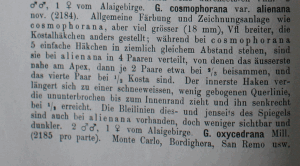

 +6Kontinente:EUAS
+6Kontinente:EUAS2. Diagnose
2.1. Erstbeschreibung
4. Weitere Informationen
4.1. Andere Kombinationen
- Grapholitha alienana Caradja, 1916 [Originalkombination]
4.2. Synonyme
- Laspeyresia pfeifferi Rebel, 1936
4.3. Faunistik
Die Art wurde aus dem "Alaigebirge" beschrieben, also wahrscheinlich aus Kirgisistan, möglicherweise auch Tadschikistan, oder eventuell sogar China.
Aarvik & Karsholt (1993) melden die Art aus dem asiatischen Teil der Türkei: "In ZMUC there is a ♂ collected at Turkey, Mersin, 10 km SE Arslanköy Taurus, 1300 m 11.VII.1987 M. Fibiger leg. (Fig. 7). We believe that this specimen represents the male of C. alienana. Externally, the Turkish specimen agrees reasonably well with the original description of alienana. Of particular significance is the characteristic, gently curved white line uniting the innermost costal strigulae and the dorsal spot. There is a discrepancy as to the wingspan of the specimens. Caradja (1916) stated it to be 18 mm. Danilevsky & Kuznetsov (1968) mentioned 14-16 mm, and as they also studied the lectotype of alienana, the measure given by Caradja must be erroneous. Our specimen measures only 11 mm. In this group, females are often much larger than males, and the difference in size between the Turkish male and the females from Alai Mts. (as given by Danilevsky & Kuznetsov) by no means rules out their conspecificity."
Nach der nicht mehr online verfügbaren Fauna Europaea kommt die Art auf den Nordägäischen Inseln (Griechenland) vor - eine konkrete Fundmeldung wurde aber nicht genannt.
Huemer et al. (2025: 11) listen die Art in ihrem Kapitel "New Records with Accompanying DNA Barcodes" als neu für Zypern und damit Europa i.w.S. auf. Gefunden wurde ein Falter mit BIN BOLD:AGP2336.
(Autor: Erwin Rennwald)
4.4. Literatur
- Aarvik, L. & O. Karsholt (1993): New and little known Grapholitini (Lepidoptera, Tortricidae) from the Mediterranean area. — Nota lepidopterologica 15 (3/4): 164-178. [Digitalisat auf www.archive.org]
- Erstbeschreibung: Caradja, A. (1916): Beitrag zur Kenntnis der geographischen Verbreitung der Pyraliden und Tortriciden des europäischen Faunengebietes, nebst Beschreibung neuer Formen. — Deutsche Entomologische Zeitschrift „Iris“ 30: 1-88, 151-152. Dresden.
- Huemer, P., Özden, Ö., Rennwald, E., Barton, I., Junnilainen, J., Hausmann, A., Nieukerken, E.J. van & P.D.N. Hebert (2025): Well-Known, Misidentified, or Unnamed? A DNA Barcode-Based Reassessment of the Lepidoptera Fauna of Cyprus Supported by Morphology. — Insects, 17 (4): 1-27. https://doi.org/10.3390/insects17010004. [zum Artikel mit PDF-Download + Supplementary material auf mdpi.com]









